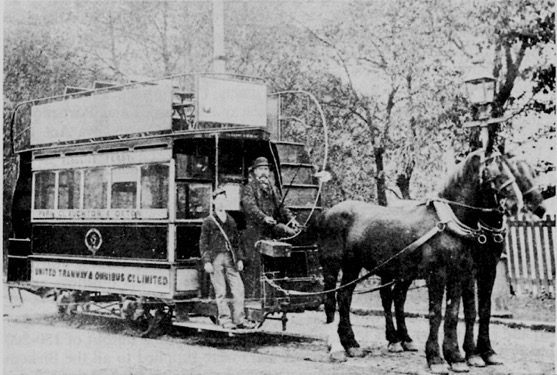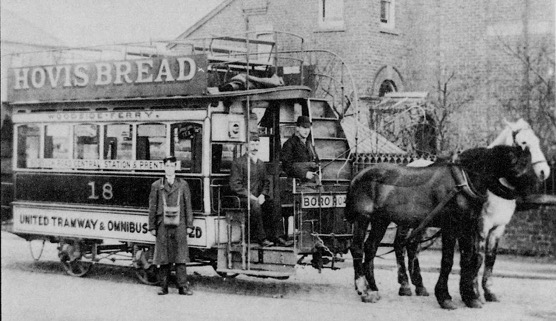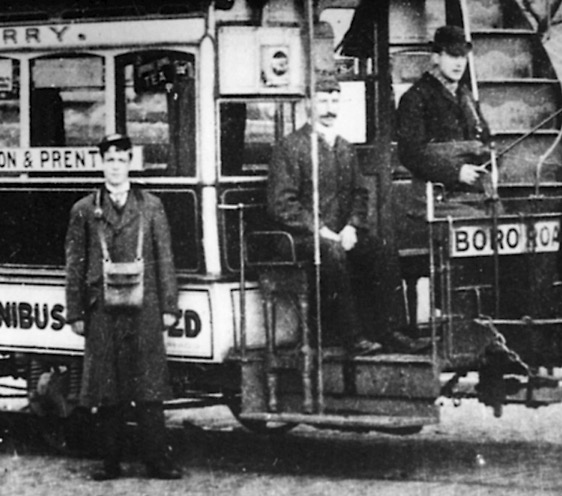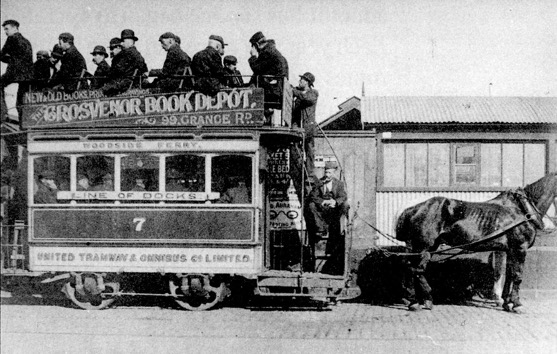Birkenhead United Tramway, Omnibus and Carriage Company
History
The Birkenhead United Tramway, Omnibus and Carriage Company was formed on 8th August 1889 to acquire the assets of the Birkenhead Tramways Company (which was in liquidation at the time) as well as those of the Birkenhead and District Omnibus and Carriage Company. Both companies had been badly impacted by the opening of the Mersey Railway Company's line under the Mersey, and its extension to Birkenhead Park Station, which saw a significant shift in the number of passengers using Woodside Ferry, which the tramway served. The BTCo was taken over on the 15th August 1890, with Birkenhead Corporation acquiring the company's tracks (circa 6.3 miles of standard-gauge horse tramway) on the same day. The BUTO&CCo was therefore the lessee of the corporation, initially on a temporary basis, but from the 1st January 1891, under a ten-year lease (signed on the 9th of July but presumably back dated), which was set to expire on the 31st December 1900.
The BTCo's standard-gauge, horse-drawn system comprised three lines, all of which ran from Woodside Ferry on the Mersey. The Docks line ran roughly northwestwards via Canning Street, Cleveland Street and Beaufort Road to a terminus at the railway station at Birkenhead Docks (owned by the Wirral Railway Company). The Oxton line branched off in Canning Street, running southwestwards along Argyle Street then northwestwards along Conway Street to Birkenhead Park gates; from here the line ran southwards along Park Road East then westwards along Park Road South to Claughton, before turning southwards once again along Palm Grove to a terminus at the latter's junction with Shrewsbury Road South. The Prenton line took a different route from the ferry, via Hamilton Street, before heading along Borough Road, westwards then southwards, to a terminus at the latter's junction with Prenton Road West. Additionally, there were a number of short connecting lines to enable operational flexibility.
The new company seems to have led a rather uneventful existence, at least by the standards of its predecessors; however, by the mid 1890s it was becoming clear that the corporation was giving serious consideration to conversion of its horse lines to electric traction, and thereafter, operating the system as a municipal concern. Powers to operate the tramways, and to use mechanical traction, including electrical, were granted to the corporation on the 15th July 1897 under the Birkenhead Corporation Act (1897). The council formally decided to proceed with the creation of a municipally operated electric tramway system in May 1898.
As the corporation already owned the tracks used by the BUTO&CCo under a lease that would expire in two-and-a-half years' time, the corporation concentrated its efforts on the other horse tramway in the borough, which was operated by the Wirral Tramway Company. This company had also suffered from railway competition, and after getting itself into financial difficulties, had been bailed out by the corporation, which bought the WTCo's tracks, but then rashly leased them back to the company under a 21-year lease that would not expire until the 10th March 1916. The corporation's greatest challenge would therefore be to buy the company out its lease, the company effectively having the whip hand, with many years of its lease still to run.
The corporation therefore sought powers to buy the WTCo out of its lease (set for the 31st December 1899), and to build an additional nine miles of tramway; these were granted on the 20th June 1899 under the Birkenhead Corporation Act (1899). Although the WTCo was allowed to continue running horse-drawn services beyond the end of the lease, and until such time as the line (to New Ferry) was ready for reconstruction, agreement on the finer details of the operational arrangement could not be reached, the WTCo running its last horse tram service on the 8th May 1900. This resulted in new business coming the way of the BUTO&CCo, as the corporation asked the latter to provide a replacement tram service on the New Ferry route, which it did from 16th May 1900 onwards.
Meanwhile, the BUTO&CCo continued to operate horse-drawn services over the system it had acquired from the BTCo, ahead of the expiry of its own lease on the 31st December 1900. With the agreement of the corporation, the company continued to provide services following the expiry of its lease, during which time the corporation commenced reconstruction of the lines for working with overhead electric traction. The last horse-tram service over former WTCo tracks ran on the 22nd January 1901, with the last BUTO&CCo-operated service of all running on the 8th November 1901.
Uniforms
Fortunately, several photographs have survived that show BUTO&CCo staff working the horse trams, so it is possible to say with some degree of certainty what attire was worn.
In common with the majority of horse tramways in the UK, drivers simply wore heavy duty informal attire — trousers, jackets, knee blankets (see the first image below) and the popular headgear of the day, the bowler hat. Conductors appear to have also worn informal jackets and trousers, though they do appear to have worn overcoats with collars of a darker material then the main body of the coat, suggesting that they were either company-issued, or perhaps more likely, that they were purchased by the men themselves at the behest of the company, but from a designated supplier. In the first photograph below, there is no reflection from the flash, suggesting that the overcoat buttons were not made of brass or nickel, and therefore, that they were probably plain (in this period, uniform buttons were always either brass or nickel, and metal buttons would not have been used on everyday working-class garments).
Conductors wore a kepi-style cap that appears to have carried a large metal badge (of unknown pattern), strongly suggesting that it was issued by the company.
Further reading
For a history of Birkenhead's tramways, see: 'The Tramways of Birkenhead and Wallasey' by T B Maund and M Jenkins; LRTA (1987).
Images

BUTCCo Horsecar No 5 standing outside Palm Grove depot — photo undated, but probably taken some time in the early 1890s given the good condition of the vehicle, which was new in 1890. The conductor appears to be wearing an informal jacket, but with a kepi-style cap, the latter more than likely issued by the tramway company. Photo courtesy of the Tramways and Light Railway Society, with thanks to David Voice.
BUTCCo Horsecar No 18 at the Borough Road terminus of the Prenton Route — photo undated, but probably taken in the mid-to-late 1890s. Photo courtesy of the Tramways and Light Railway Society, with thanks to David Voice.
An enlargement of the above photograph showing the tramcar staff. The conductor appears to be wearing a long overcoat with dark collars and a kepi-style cap bearing a large metal badge. The driver is wearing heavy-duty informal attire, and the normal headgear for his profession during this period — a bowler hat.
BUTCCo Horsecar No 7 standing at Woodside — photo undated, but probably taken in the early 1890s. Only the driver can be seen — seated facing the camera — and he is clearly wearing informal attire. Photo courtesy of the Tramways and Light Railway Society, with thanks to David Voice.